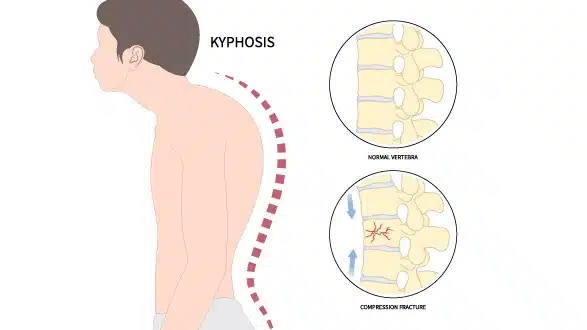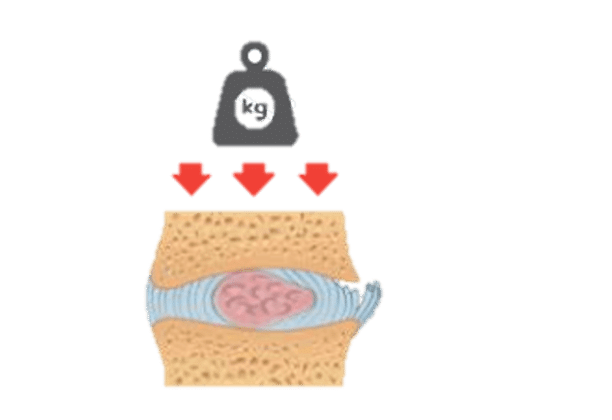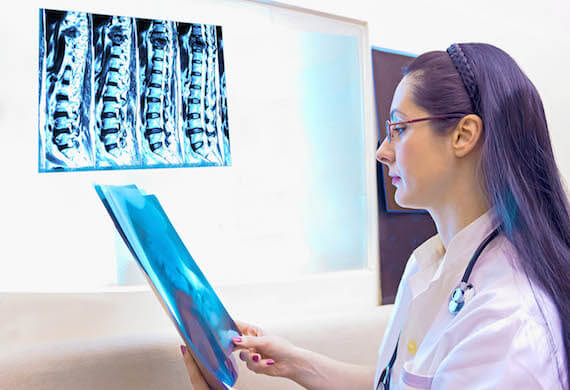Request Appointment
Enter your details and we will be in touch with you shortly;
Or call
8655885566
between 8 am and 8 pm.

Abnormal convexity of spine in thoracic and sacral region

Kyphosis is a medical condition whereby the upper region of the spine is concave or rounded looking like a hump. Kyphosis is also known as “roundback" or "humpback”. It may arise from poor posture practices, spinal injuries, or perhaps inherited factors. Besides, while a slight curve is normal, a curve of more than 45 degrees is considered abnormal. Scheuermann’s kyphosis occurs at adolescence and is usually caused by congenital abnormalities, while others are due to diseases that affect the elderly population. Malpositioning is another common factor contributing to this condition because the curve gets exacerbated over a period.
This condition may cause rigidity, back aches, and tiredness that may be felt when one is standing or sitting for a lengthy period. Sometimes this may lead to problems connected with the lungs as the chest cavity is under pressure. Early detection plays a key role in kyphosis management.
Effective kyphosis treatment depends on the severity of the curve. Mild cases can improve with postural exercises and kyphosis therapy, which focus on strengthening back muscles and improving spinal alignment. For more significant cases, kyphosis braces may help in spinal curvature correction during adolescent growth phases.
Kyphosis symptoms are most visible in appearance itself, with the top arch of the back appearing excessively rounded, creating a hunchback or hump-like appearance. However, this is not the only symptom, and patients may also observe the following:
Kyphosis is not a single form but is subdivided according to the cause and pattern of spinal curvature disorders. Scheuermann’s kyphosis and congenital kyphosis are related to the development is vertebral deformity during growth or before birth.
In the adult population, change can occur degenerative, traumatic, neuromuscular, and infectious diseases, and specific subtypes such as cervical kyphosis, also called ‘‘military neck’’ or excessive hyperkyphosis.
This form of humpback is a result of slouching or muscle imbalances, which result in a soft and flexible curve that disappears as soon as the person lies down. It is most common among adolescents and office workers. Simple Posture improvement methods, such as ergonomic adjustments and mindful sitting, can reverse mild curvature. Although it does not lead to the growth of structural tissues of the body, it may cause muscular weariness and minor discomfort.
Scheuermann’s kyphosis occurs during the age of growth spurt when vertebral bodies take a wedged shape. Although it is a rigid curve, it usually does not sit well when supine; it can only do this after clinical support and a sling. Physical assessment, therefore, uses the vertebral wedge angle from which the intervention plan is initiated.
As one of the causes of spinal deformities, congenital kyphosis is present at birth because the condition results from vertebral formation or segmentation abnormalities during the development of the fetus. Some of the fixed deformities do not regress; on the other hand, they may even worsen over time. Imagining tests help to decide whether the spine should be monitored conservatively or fusion should be performed.
Cervical kyphosis entails a loss of cervical lordosis, resulting in a straight or kyphotic cervical spine. Some of the most common causes include whiplash, degenerative disc disease, and long-term compromised posture.
Hyperkyphosis is a thoracic curvature that has surpassed what is considered normal for the human spine. The patients may also experience respiratory problems since the internal bleeding may take up their chest space.
Other types include congenital kyphosis due to disc degeneration and osteoporosis in elderly people, traumatic kyphosis due to spinal fracture, and neuromuscular kyphosis in diseases like muscular dystrophy. Infective kyphosis, like Pott’s disease, leads to collapse of vertebrae where infection occurs in the spine.
Patients with painful curves may benefit from kyphosis relief therapy to reduce stiffness and improve function. Corticosteroids and other inflammation reducers may also help reduce false joints and pain, but they are mostly used as a last resort.
 Professional diagnosis required
Professional diagnosis required Chronic, can last for years
Chronic, can last for years Treatable with 8 weeks of QI Spine Therapy
Treatable with 8 weeks of QI Spine TherapyKyphosis can occur for various reasons, including disc degeneration, osteoporosis, or postural problems. The most common causes of kyphosis include the following:
Various causes are associated with the development and progression of kyphosis. The stated are easier to determine earlier, hence facilitating more preventive monitoring and control measures are necessary.
Reduced bone mass can be considered a precursor to different degrees of micro-lesions, such as those in the thoracic spine being the most affected and which increases the degree of kyphosis. Such cracks may develop progressively, giving a step-like appearance.
Structural defects like the absence of the lower half of the vertebral through growth or hemivertebrae uncover the spacing issues in the vertebrae and give rise to early-onset, progressive, and commonly kyphotic deformities as often as which can be surgical.
Chronic slouching, exacerbated by extended screen use or heavy backpacks, places uneven stress on thoracic vertebrae, potentially necessitating kyphosis treatment to restore alignment.
Structural anomalies such as cerebral palsy or muscular dystrophy affect coordination and muscle tone, which reduces spine support and contributes to the development of abnormal curvature of the spine.
Acute or chronic kyphosis is caused by vertebral fractures, ligament tears or injury, or surgical mishaps, which negatively affect the structural balance of the spinal column.
Prolonged sitting, lack of core-strengthening exercise, and improper lifting techniques weaken back extensors, underscoring the importance of posture improvement to maintain spinal health.
The hereditary factor, in particular vertebral morphology, makes the individual more susceptible in cases of a family predisposition to spinal deformities.
Early recognition of these factors enables timely kyphosis therapy, including bracing, targeted exercise, and manual techniques, as well as specialized spinal therapy.
 Professional diagnosis required
Professional diagnosis required Chronic, can last for years
Chronic, can last for years Treatable with 4 weeks of QI Spine Therapy
Treatable with 4 weeks of QI Spine TherapyKyphosis treatment varies among patients, depending on how severe the curvature is, and also on the prevalence of other symptoms like back pain. Surgical intervention is only recommended in rare cases when the curvature is over 70%.
Conservative treatments are considered to be the best option as they help to control pain as well as prevent the progression of the condition. These are a few of the treatments for kyphosis:
Kyphosis, which is caused by a structural problem, is often treated by wearing a special kyphosis braces, which stops or at least slows down the progression of the curve. This also helps to reduce the pressure and stress placed on the other structures of the back, which in turn reduces back pain. Spine specialists will provide a brace that is custom-fitted to your body, as this will improve the therapeutic effects of the brace.
Kyphosis can place a great deal of stress on the rest of the back and can even cause vertebrae to become misaligned. Spinal manipulation eases muscle tension and ensures that the vertebrae remain correctly aligned, which reduces back pain.
Posture modification is an important part of managing kyphosis pain, as bad posture can aggravate the condition and drastically increase the severity of the pain. A spine specialist will be able to look at your work and home environments and suggest changes that will promote good posture.
Smoking reduces the amount of oxygen that goes to the rest of your body, including your back. Several studies show that smoking increases the incidence and severity of back pain, so spine specialists strongly urge their patients to completely quit smoking.
Patients with kyphosis who experience moderate or severe pain will benefit from nonsurgical spine treatments such as acupuncture, acupressure, and frequency-specific microcurrent therapy. TENS (transcutaneous electrical nerve stimulation) is another effective method of pain control. This method uses mild electrical currents to reduce pain, so unlike pain medications, it does not have any lasting side effects.
If your back pain is severe or if it increases, it could indicate that you have suffered a mild fracture. Fractures can aggravate kyphosis, so please consult a spine specialist as soon as possible.
The kyphosis therapy is not limited to medical methodologies only. People’s daily activities could help slow down the progression and lessen the level of pain. Below is a positive way of ensuring that you manage your spine health through little efforts in the long run:
People should also be conscious of how they sit, stand, or even walk. Slightly retract your shoulders, but do not tense them up too much. If you spend the majority of your time in front of the computer, take note of the height of the chair and the computer display to maintain appropriate posture for your body. The next thing is to incorporate the use of a lumbar support pillow to minimize the controversial slouching while seated.
There are easy neck and chest exercises that can be done to overcome this problem, which involve stretching and building the upper back muscles.
To condition, they should sit on chairs that offer back support while sleeping on a medium-firm mattress. Exclude soft furniture that may cause the occupants to recline or lie down a lot.
Sedentary types of workouts, such as walking, swimming, or cycling, make the spine active. One should avoid lifting heavy objects or twisting the back in a manner that requires the bending of your back by any chance without consulting a therapist.
Use applications of heat for stiffness and use ice from time to time for inflammation. Light tissue massage, such as a self-massage using a foam roller, might also be beneficial to relax tight muscles.
Adequate calcium and vitamin D intake is necessary to help in the building of strong bones. Drink a lot of water and have some foods with anti-inflammatory nutrients, including green onions, omega-3 fish, and blueberries.
When you use bags frequently, the two straps should be used to ensure that the load is well distributed. Do not carry bulk by walking around, particularly if you are a student or a commuter with a heavy backpack.
It is important to follow up with your doctor or a physiotherapist whenever you are given the green light to do so. Stable monitoring implies that any changes are detected early so that treatment is administered if the condition worsens.
Sitting habits can cause a lot of damage to our spine and overall health. Thus, when it comes to fixing or preventing it, it is not about performing drastic measures once but incorporating simple, correct posture practices into our daily routine. Besides managing kyphosis, these consistent practices support the well-being and functioning of the spine, as well as personal confidence in movement.
 Professional diagnosis required
Professional diagnosis required Chronic, can last for years
Chronic, can last for years Treatable with 4 weeks of QI Spine Therapy
Treatable with 4 weeks of QI Spine TherapyTreatment for kyphosis vary among patients, depending on how severe the curvature is, and also on the prevalence of other symptoms like back pain. Surgical intervention is only recommended in rare cases when the curvature is over 70%.
Conservative treatments are considered to be the best option as they help to control pain as well as prevent the progression of the condition. These are a few of the treatments for kyphosis:
Kyphosis that is caused by a structural problem is often treated by wearing a special brace which stops or at least slows down the progression of the curve. This also helps to reduce the pressure and stress placed on the other structures of the back which in turn reduces back pain. Spine specialists will provide a brace that is custom-fitted to your body as this will improve the therapeutic effects of the brace.
Kyphosis can place a great deal of stress on the rest of the back and can even cause vertebrae to become misaligned. Spinal manipulation eases muscle tension and ensure that the vertebrae remain correctly aligned which reduces back pain.
Posture modification is an important part of managing kyphosis pain as bad posture can aggravate the condition and drastically increase the severity of the pain. A spine specialist will be able to look at your work and home environments and suggest changes that will promote good posture.
Smoking reduces the amount of oxygen that goes to the rest of your body, including your back. Several studies show that smoking increases the incidence and severity of back pain so spine specialists strongly urge their patients to completely quit cigarettes.
Patients with kyphosis who experience moderate or severe pain will benefit from nonsurgical spine treatments such as acupuncture, acupressure, and frequency specific micro current therapy. TENS (transcutaneous electrical nerve stimulation) is another effective method of pain control. This method uses mild electrical currents to reduce pain so unlike pain medications, it does not have any lasting side effects.
If your back pain is severe or if it increases, it could indicate that you have suffered a mild fracture. Fractures can aggravate kyphosis so please consult a spine specialist as soon as possible.
 Professional diagnosis required
Professional diagnosis required Chronic, can last for years
Chronic, can last for years Treatable with 4 weeks of QI Spine Therapy
Treatable with 4 weeks of QI Spine TherapyAccurate diagnosis of kyphosis guides effective kyphosis relief treatment and long-term kyphosis management. The assessment usually goes through the following phases:
At QI Spine, the diagnosis is done by asking about the patient’s history, conducting a thorough physical examination, and doing DSA (Digital Spine Analysis test), which helps in analyzing the root cause of the problem. It is a non-invasive functional test that helps in measuring spine function. Its controlled and guided movements help in determining the mobility of the spine, strength, and imbalances of muscles around the spine.
CT scans, MRIs, and X-rays often fail to pinpoint the exact source of pain, whereas DSA directly analyzes muscle tissue to identify the root cause. Here is how DSA is conducted & its benefits:
Detailed clinical history, tests, and diagnostic injections coupled with advanced imaging, sonoelastography, DSA, and bone scan determine kyphosis. Once confirmed, a personalized kyphosis relief treatment program of spinal therapy, including kyphosis exercises and manual techniques, restores muscle balance, relieves nerve compression, and facilitates successful long‑term pain management for kyphosis.
 Professional diagnosis required
Professional diagnosis required Chronic, can last for years
Chronic, can last for years Treatable with 4 weeks of QI Spine Therapy
Treatable with 4 weeks of QI Spine Therapy


Have a question?
Ask our spine specialists
Who is a QI Spine Specialist?
A QI Spine Specialist is a medical expert with

Dr. Nidhi Sanghvi Shah

Dr. Shital Gaikwad

Dr. Richa Bhatia
9000 hours
of specialisation in treating back and neck conditions
32 hours
of spine physiotherapy specialisation methods in McKenzie concepts, Kinetic control, Neurodynamic solutions, Mulligan’s concepts
500 hours
and 6 months of QI Spine specialisation courses
Kyphosis is a forward rounding at the upper spine, contributing to the hunchback posture. Lordosis is a curvature of the spine that is referred to as swaying of the lower back, resulting in protrusion of the abdomen. Both conditions cause spinal deformity and impact the position of the spine.
Yes, it is possible to correct mild postural kyphosis through exercise that aims at strengthening the spine and also offering it the much needed flexibility. Some of the effective exercises which are recommended are the chin tucks, wall angels and thoracic extensions, cat-cow stretch and finally the resistance band rows. These help with posture improvement and spinal support.
Scheuermann’s kyphosis is treatable via physical therapy especially when diagnosed early and lifestyle changes to improve posture. Structural kyphosis may not be fully reversible, but it can be managed through kyphosis braces and kyphosis exercises. Peculiar approaches may slow down the degenerative process or alleviate patient’s sufferings at least.
Avoid getting into sleep on your back particularly on a flat pillow and a cushion on your knees to minimize pressure on the spine. Lying on your stomach or using a thick pillow that tilts the neck forward should also be discouraged. It also ensures that the spine of the body is well aligned when one is asleep by providing a firm surface to sleep on.